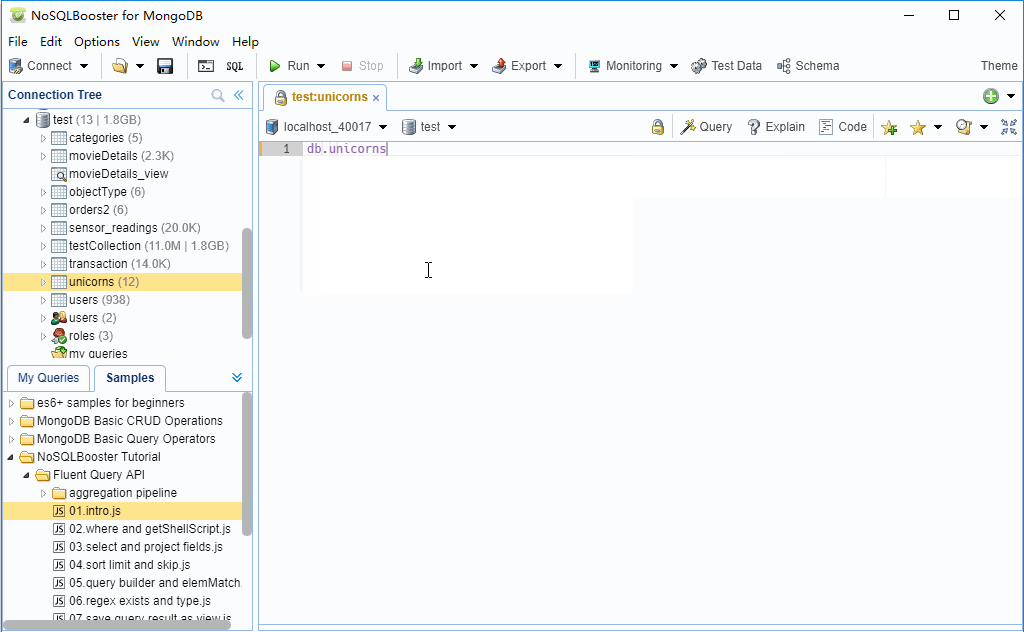mongodb学习总结
mongodb学习总结
一丶什么是MongoDB
MongoDB是一个基于分布式文件存储的数据库, 由C++语言编写.旨在为WEB应用提供可扩展的高性能数据存储解决方案.MongoDB是一个结余关系数据库和非关系数据库之间的产品, 是非关系数据库当中功能最丰富,最像关系数据库的.
二丶MongoDB的基本概念
MongoDB将数据存储为一个文档, 数据结构由键值(key=>value)对组成.
MongoDB文档类似于JSON对象. 字段值可以包含其他文档, 数组及文档数组.
{ "name":"timfruit", "age": 24, "hobby":["pingpong", "note"] }
MongoDB中的基本概念是文档丶集合丶数据库.
MongoDB是面向文档的数据库, MongoDB中的文档相当于Mysql表中的一行数据, MongoDB中的文档是保存在集合中的, 向集合中插进一份文档, 相当于向MySql表中插入一行数据, 也就是说MongoDB中的集合类似于Mysql中的表.Mongodb的集合是保存在数据库中的, 在MongoDB的数据库中创建一个集合, 相当于在Mysql中database中创建一个


三丶mongodb的基本操作(CRUD)
请先自行安装mongodb
-- 运行mongod服务

-- 运行mongo客户端(可与服务进行交互)

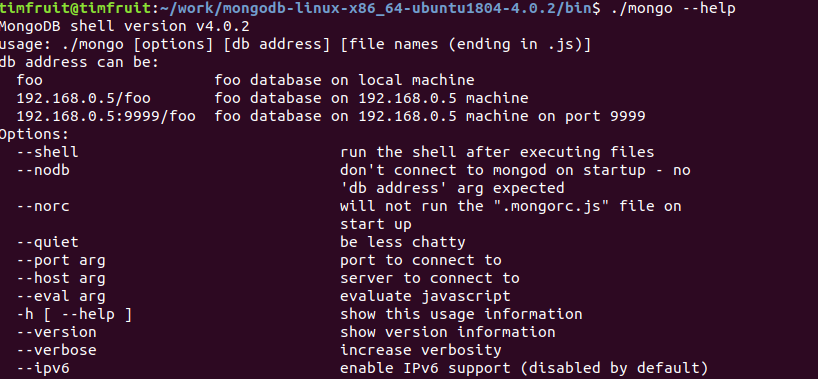
3.1)查看数据库
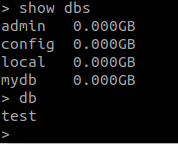
show dbs 查看所有数据库
db 查看正在使用的数据库
3.2) 创建MongoDB数据库
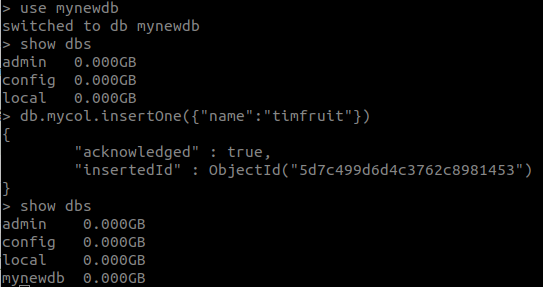
use <database> 并没有真正创建数据库, 而是插入了一些数据之后, 才会创建数据库和集合
3.3) 插入文档
db.inventory.insertOne( { item: "canvas", qty: 100, tags: ["cotton"], size: { h: 28, w: 35.5, uom: "cm" } } )
查看结果

插入多份文档
db.inventory.insertMany([ { item: "journal", qty: 25, tags: ["blank", "red"], size: { h: 14, w: 21, uom: "cm" } }, { item: "mat", qty: 85, tags: ["gray"], size: { h: 27.9, w: 35.5, uom: "cm" } }, { item: "mousepad", qty: 25, tags: ["gel", "blue"], size: { h: 19, w: 22.85, uom: "cm" } } ])
db.collection.insert()插入一份或者多份文档
3.4) 查询文档
准备数据
db.inventory.insertMany([ { item: "journal", qty: 25, size: { h: 14, w: 21, uom: "cm" }, status: "A" }, { item: "notebook", qty: 50, size: { h: 8.5, w: 11, uom: "in" }, status: "A" }, { item: "paper", qty: 100, size: { h: 8.5, w: 11, uom: "in" }, status: "D" }, { item: "planner", qty: 75, size: { h: 22.85, w: 30, uom: "cm" }, status: "D" }, { item: "postcard", qty: 45, size: { h: 10, w: 15.25, uom: "cm" }, status: "A" } ]);
a) 查询所有数据
db.inventory.find( {} )
相当于sql
SELECT * FROM inventory
b) 精确的等值查询
精确的等值条件可以使用{<field1>: <value1>, ... }
db.inventory.find( { status: "D" } )
相当于SQL
SELECT * FROM inventory WHERE status = "D"
查询过滤器, 即查询条件的写法形式, 等值形式, <field>:<value>, 条件查询里的操作符形式 <field>: {<operator>: <value>}
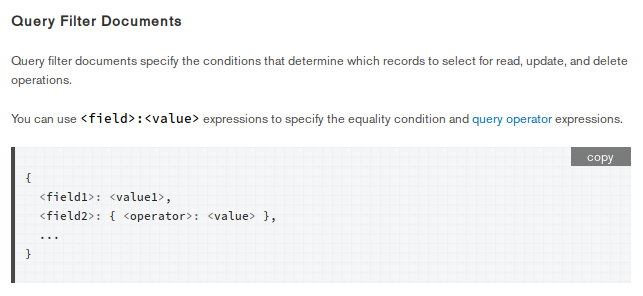
c)使用操作符进行条件查询
条件查询操作符形式: { <field1>: { <operator1>: <value1> }, ... }
db.inventory.find( { status: { $in: [ "A", "D" ] } } )
相当于SQL
SELECT * FROM inventory WHERE status in ("A", "D")
d) 精准 AND 条件 查询
查询inventory集合中status="A" 而且 qty<30的文档:
db.inventory.find( { status: "A", qty: { $lt: 30 } } )
相当于SQL
SELECT * FROM inventory WHERE status = "A" AND qty < 30
e)精准 OR 条件 查询
{$or: [ {<field>:<value>, <field>:{<operator>: <value>}} ] }
查询inventory中status="A" 或者 qty<30的文档
db.inventory.find( { $or: [ { status: "A" }, { qty: { $lt: 30 } } ] } )
相当于SQL
SELECT * FROM inventory WHERE status = "A" OR qty < 30
f) AND , OR 混合查询
db.inventory.find( { status: "A", $or: [ { qty: { $lt: 30 } }, { item: /^p/ } ] } )
相当于SQL
SELECT * FROM inventory WHERE status = "A" AND ( qty < 30 OR item LIKE "p%")
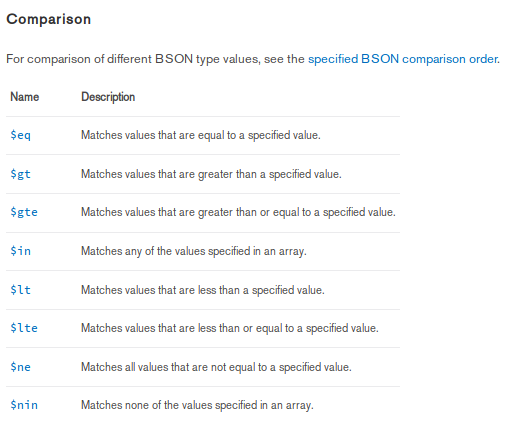

g) 投影, 指定返回值
db.inventory.find( { status: "A" }, { item: 1, status: 1 } )
相当于SQL:
SELECT _id, item, status from inventory WHERE status = "A"
3.5)更新修改文档
准备数据
db.inventory.insertMany( [ { item: "canvas", qty: 100, size: { h: 28, w: 35.5, uom: "cm" }, status: "A" }, { item: "journal", qty: 25, size: { h: 14, w: 21, uom: "cm" }, status: "A" }, { item: "mat", qty: 85, size: { h: 27.9, w: 35.5, uom: "cm" }, status: "A" }, { item: "mousepad", qty: 25, size: { h: 19, w: 22.85, uom: "cm" }, status: "P" }, { item: "notebook", qty: 50, size: { h: 8.5, w: 11, uom: "in" }, status: "P" }, { item: "paper", qty: 100, size: { h: 8.5, w: 11, uom: "in" }, status: "D" }, { item: "planner", qty: 75, size: { h: 22.85, w: 30, uom: "cm" }, status: "D" }, { item: "postcard", qty: 45, size: { h: 10, w: 15.25, uom: "cm" }, status: "A" }, { item: "sketchbook", qty: 80, size: { h: 14, w: 21, uom: "cm" }, status: "A" }, { item: "sketch pad", qty: 95, size: { h: 22.85, w: 30.5, uom: "cm" }, status: "A" } ] );
a) 在一个集合里更新文档
{ <update operator>: { <field1>: <value1>, ... }, <update operator>: { <field2>: <value2>, ... }, ... }
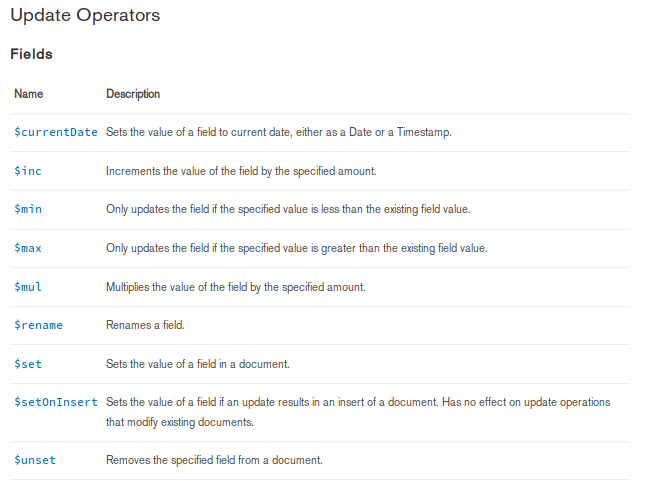
将item属性为paper的文档 中的"com.uom"属性设置为"cm", "status"属性设置为"P", 添加lastModified属性的字段, 并设置为$currentDate当前时间.
db.inventory.updateOne( { item: "paper" }, { $set: { "size.uom": "cm", status: "P" }, $currentDate: { lastModified: true } } )
修改的结果为:
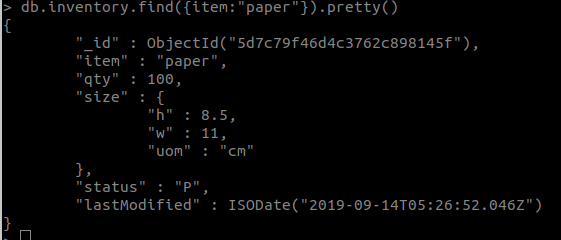
b) 在一个集合里修改多份文档
将所有qty<50的文档, 修改对应值, 增加修改时间字段
db.inventory.updateMany( { "qty": { $lt: 50 } }, { $set: { "size.uom": "in", status: "P" }, $currentDate: { lastModified: true } } )
c) 替换文档
将item为paper的文档, 替换成指定文档.
db.inventory.replaceOne( { item: "paper" }, { item: "paper", instock: [ { warehouse: "A", qty: 60 }, { warehouse: "B", qty: 40 } ] } )
修改之前:
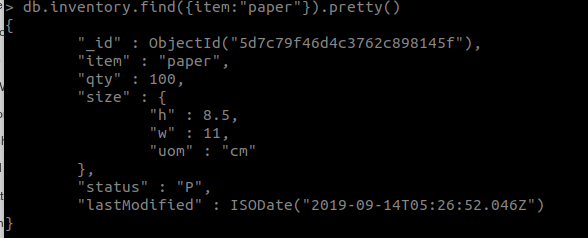
修改之后:

d)修改字段名:
{$rename: { <field1>: <newName1>, <field2>: <newName2>, ... } }
将item为canvas的文档中的"status"属性名 改为 "newstatus"
db.inventory.update({item:"canvas"},{$rename:{"status":"newstatus"}})
修改结果为:
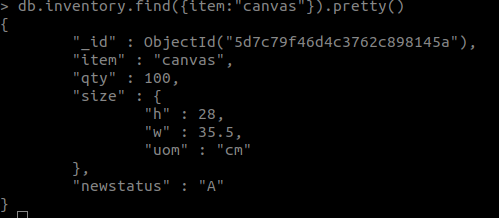
3.6) 删除文档
清空之前的数据: db.inventory.remove({})
准备数据:
db.inventory.insertMany( [ { item: "journal", qty: 25, size: { h: 14, w: 21, uom: "cm" }, status: "A" }, { item: "notebook", qty: 50, size: { h: 8.5, w: 11, uom: "in" }, status: "P" }, { item: "paper", qty: 100, size: { h: 8.5, w: 11, uom: "in" }, status: "D" }, { item: "planner", qty: 75, size: { h: 22.85, w: 30, uom: "cm" }, status: "D" }, { item: "postcard", qty: 45, size: { h: 10, w: 15.25, uom: "cm" }, status: "A" }, ] );
a) 删除匹配的多份文档中的第一份文档
db.inventory.deleteOne({status:"A"})

b) 删除匹配的多份文档
db.inventory.deleteMany({status:"D"})

c) 删除所有
db.inventory.deleteMany({})
3.7) 批量写
db.collection.bulkWrite()提供批量插入,更新,删除的操作.MongoDb的批量插入也可以通过db.collection.insertMany()方法.
bulk wirte操作可以是有序的(ordered), 也可以是无序的(unordered).
有序执行一系列的操作, MongoDB将会串行执行. 一旦发生一个操作出错, MongoDB将会立即返回.
无序执行一系列的操作, MongoDB可以并行执行,但行为不能被保证. 如果出错, MongoDB将会继续执行.
在分片集合中执行一批有序操作, 将会比无序操作更慢, 因为有序操作需要串行等待执行.
准备数据:
db.inventory.insertMany([ { "_id" : 1, "char" : "Brisbane", "class" : "monk", "lvl" : 4 }, { "_id" : 2, "char" : "Eldon", "class" : "alchemist", "lvl" : 3 }, { "_id" : 3, "char" : "Meldane", "class" : "ranger", "lvl" : 3 } ]);
将一系列操作批量执行 :
db.characters.bulkWrite( [ { insertOne : { "document" : { "_id" : 4, "char" : "Dithras", "class" : "barbarian", "lvl" : 4 } } }, { insertOne : { "document" : { "_id" : 5, "char" : "Taeln", "class" : "fighter", "lvl" : 3 } } }, { updateOne : { "filter" : { "char" : "Eldon" }, "update" : { $set : { "status" : "Critical Injury" } } } }, { deleteOne : { "filter" : { "char" : "Brisbane"} } }, { replaceOne : { "filter" : { "char" : "Meldane" }, "replacement" : { "char" : "Tanys", "class" : "oracle", "lvl" : 4 } } } ] );
返回结果为:
{ "acknowledged" : true, "deletedCount" : 0, "insertedCount" : 2, "matchedCount" : 0, "upsertedCount" : 0, "insertedIds" : { "0" : 4, "1" : 5 }, "upsertedIds" : { } }
3.7)在配置复制集时的读隔离级别
四丶聚合操作
聚合操作处理多条数据记录和返回计算结果
1) 聚合pipeline
准备数据:
db.inventory.insertMany( [ { item: "canvas", qty: 100, size: { h: 28, w: 35.5, uom: "cm" }, status: "A" }, { item: "journal", qty: 25, size: { h: 14, w: 21, uom: "cm" }, status: "A" }, { item: "mat", qty: 85, size: { h: 27.9, w: 35.5, uom: "cm" }, status: "A" }, { item: "mousepad", qty: 25, size: { h: 19, w: 22.85, uom: "cm" }, status: "P" }, { item: "notebook", qty: 50, size: { h: 8.5, w: 11, uom: "in" }, status: "P" }, { item: "paper", qty: 100, size: { h: 8.5, w: 11, uom: "in" }, status: "D" }, { item: "planner", qty: 75, size: { h: 22.85, w: 30, uom: "cm" }, status: "D" }, { item: "postcard", qty: 45, size: { h: 10, w: 15.25, uom: "cm" }, status: "A" }, { item: "sketchbook", qty: 80, size: { h: 14, w: 21, uom: "cm" }, status: "A" }, { item: "sketch pad", qty: 95, size: { h: 22.85, w: 30.5, uom: "cm" }, status: "A" } ] );
使用格式为
db.collection.aggregate( [ { <stage> }, ... ] )
a)使用案例1
查询所有qty属性值小于100的文档, 并返回所有"qty"的值
db.inventory.aggregate([ {$match:{ "qty":{"$lt":100} }}, {$project: {"qty":1} } ]);
$match: 为匹配stage, 值可以是正常的查询语句
$project: 为投影stage, 值是指定需要返回的属性
输出结果为:

b) 使用案例2
对所有"qty"值小于100的文档, 以"status"分组, 并计算"qty"的总数
db.inventory.aggregate([ {$match:{ "qty":{"$lt":100} }}, {$group: {_id:"$status", total: {"$sum": "$qty"} } } ]);
结果为:

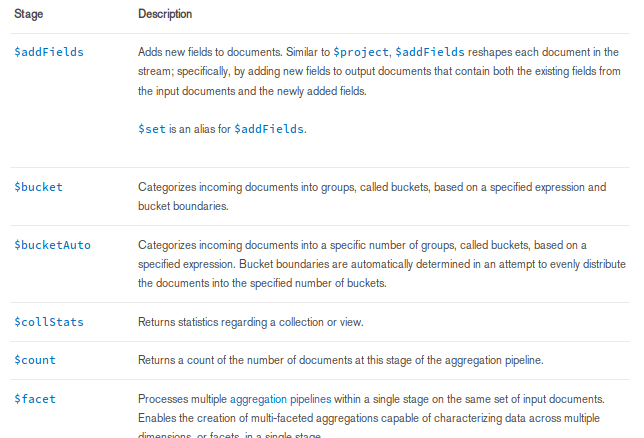
2) map-reduce
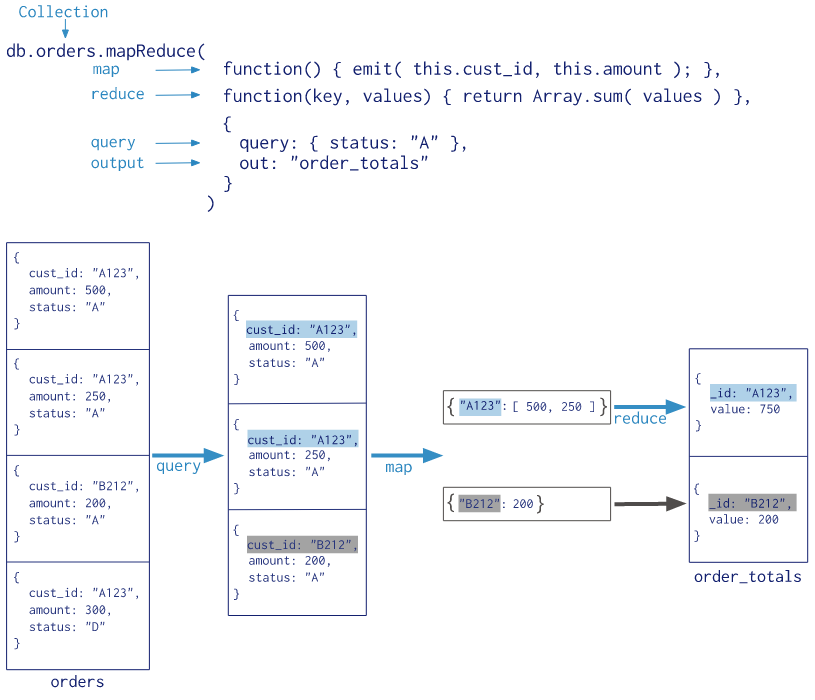
五丶索引
mongo的索引和其他数据库的索引类似,用于加快查询.
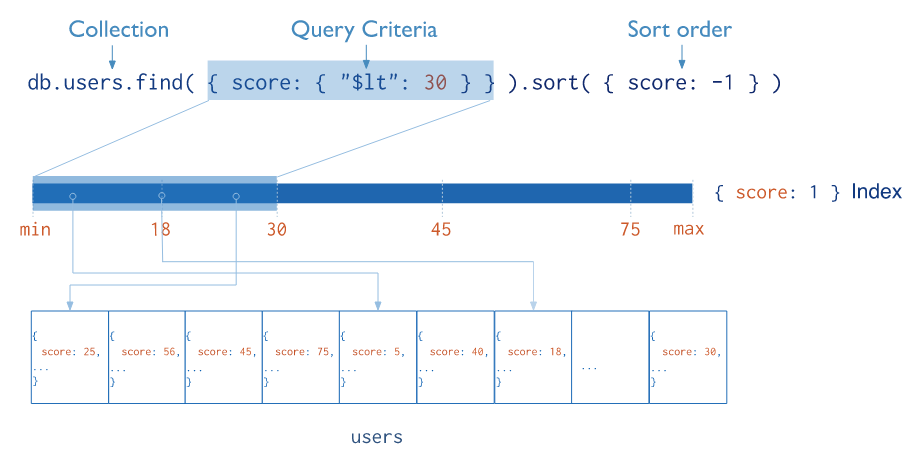
1. 创建索引
db.collection.createIndex( <key and index type specification>, <options> )
举例,
db.mycol.createIndex( { name: -1 } )
如果集合mycol中的name字段没有一样的索引定义, 将创建该索引
2. 索引名字
使用{ item : 1, quantity: -1 }语句创建索引, 默认索引名字为item_1_quantity_-1
使用如下语句, 可以指定索引名字
db.products.createIndex( { item: 1, quantity: -1 } , { name: "query for inventory" } )
3. 查看索引
db.mycol.getIndexes()
4. 删除索引
删除在属性"tx-id"上的索引
db.accounts.dropIndex( { "tax-id": 1 } )
删除集合的所有索引
db.mycol.dropIndexes()
5. 索引类型
六丶Mongodb界面工具
本人使用nosqlbooster , 因为它跨平台
